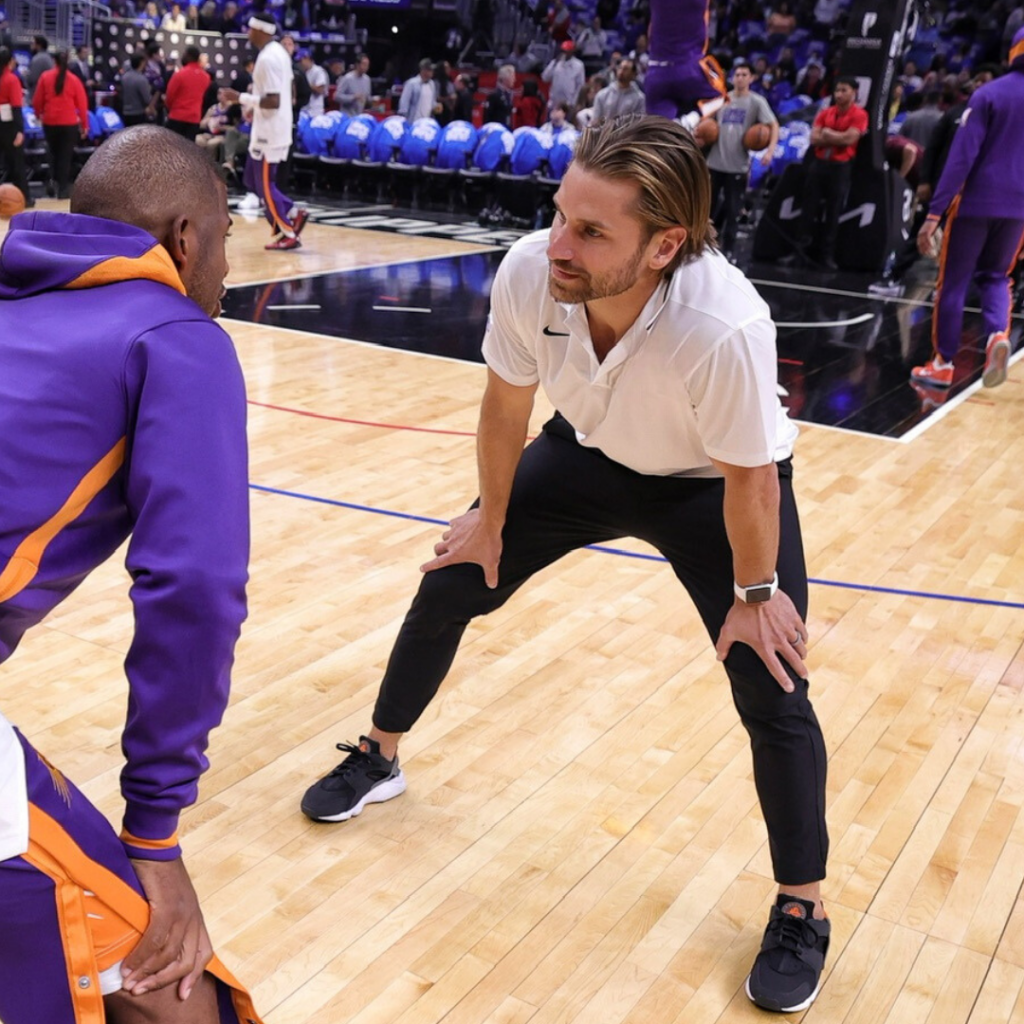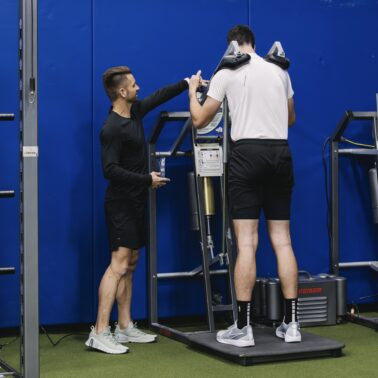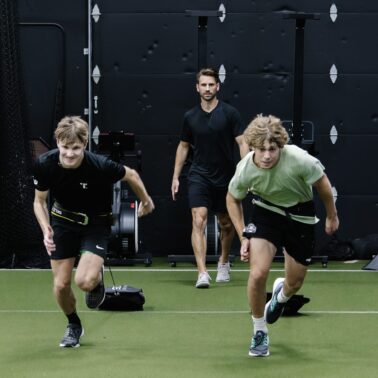“In return to play, plans must be flexible based on context. Processes must be consistent but adaptable. Principles must be concrete to establish a belief system.”
Adam Loiacono
What You Will Learn
- What the 10 foundational Principles to sports rehab are.
- Two key components of a consistent Process.
- The importance of context and systems thinking for rehab Plans.
The 3P Framework all started in The Purple Room at IFAST in Indianapolis (IYKYK). The goal of The 3P Framework is to create a consistent technical and tactical model for sports rehab. I at times fall victim to social media and want to change my rehab plans based on some new technique or research. It’s hard to be consistent, because consistent is boring. But consistent is what works, and what makes for great rehab.
Principles
a fundamental truth or belief that serves as the foundation for a System.
A close mentor of mine once shared this perspective to me. There are dozens of water bottles in the grocery store in the water aisle. Each of them is marketed a specific way or has a small tweak to their formula. But, no matter how you spin it, each bottle of water has the same foundation…H – 2 – O.
Rehab has existed for decades. From my perspective, there hasn’t been many breakthroughs lately that are truly changing the foundations of rehab. Why is that? Because speaking from an evolution perspective, despite our modern world around us evolving rapidly, physiology of our species as humans as not changed all that much in the past thousands of years.
Therefore, I believe in 10 key Principles that underly my rehab – like how H2O underlies every bottle of water. I find that many of these Principles you will find in many commercial models and continuing educations courses. If you’re willing to ask some deeper questions and pull back some of the marketing, then I think you will too.
- Coordinate Movement
- Force Management
- Fitness
- Commit & Learn
- Context Matters
- N=1
- Prioritize & Simplify
- Invest in Preparation, Not Prediction
- Treat the Person, Not the Diagnosis
- Consistency is King
Process
a series of steps taken in order turn Principles from theory into actionable, pragmatic solutions.
The Philadelphia 76ers coined the phrase “The Process.” Jury is still out if their process was successful. Regardless of their outcome, they believed in a consistent way of doing things to achieve a long-term goal. Rehab is no different.
The challenge is foundational Principles are not sexy and every week new tech is coming out to encourage a faster return to play. Layer that with a modern-day athlete who is overly stimulated and seeking that dopamine drip constantly, and we have a recipe for wanting to change things frequently.
Successful rehab requires a consistent Process. The Process must be structured enough where it repeatable, yet flexible enough to adapt to the chaos of sports teams. Two key ideas that exist in my Process are Experiment & Exposure.
safe to fail experiments
I believe in the phrase “Safe to fail experiments.” These types of experiments are providing interventions to determine if this is the right one. They also need to be safe enough that in the event the intervention fails at achieving the outcome, then at least we created no harm.
For example, I have an athlete that I need to challenge in the vertical vector in rehab. There are 101 ways to do this. I will “experiment” with exercise selection of squat variations until I achieve the desired adaptation or outcome. I refuse to be rigid in my thinking and force a solution in rehab. If in my head it made sense but in practice it did not work, then I need to be flexible with my interventions.
The interventions, squat variations, are safe to perform. Some of them will fail and that’s OK. We learn from failures in rehab if the failures are small and not catastrophic. We necessarily do not always have the answer leading into a rehab case. Over time with experience the experiments lessen, failures occur less, and we become more precise with our thinking.
An example of an Experiment that is not safe would be challenging the same athlete in the vertical vector with depth jumps rather than closed chain squatting. Could they tolerate the depth jumps? Maybe. But if they fail and their knee gives out, is that safe? Probably not.
Exposure
Exposure is the premise of almost all things that change in life. Want to lose weight? Gradually exposure yourself to lower calories. Want to overcome PTSD from a car crash? Gradually exposure yourself to short, slow car rides.. Want to grow bigger biceps? Gradually expose yourself to heavier weights.
Rehab is no different and that is why Exposure is important to the 3P Framework. The human body just went through trauma – an injury. The body needs gradual exposure to the things it was once able to do. As Jim Collins said in his book Great by Choice – “Slow when you can, fast when you must.” The human body doesn’t like fast changes. Neither does rehab. Gradually expose the rehab to stressors over time.

plans
a course of action intended to amplify desirable adaptations or dampen undesirable adaptations.
Much of my thinking for rehab is rooted in Dynamic Systems Theory (DST) of human development. The 10,000-foot view of DST is that there is a non-linear relationship to human development based on (3) key variables. These variables are:
- The Individual (the player)
- The Task (returning to a particular sport)
- The Environment (the actual playing field, the weight room, & the training room)
These (3) components are also drastically influenced by (2) major constraints:
- Internal, intrinsic (i.e., height, limb size, injury history)
- External, or extrinsic (i.e., size of playing field, size of ball, minutes played)
Intrinsic constraints are more difficult to control. External constraints I may be able to manipulate during rehab. Below is a thought experiment on how to apply these concepts to an acute ankle sprain for an NBA professional basketball player.
- Individual – an NBA basketball player
- Internal constraints – past injury history, motivation, joint laxity.
- External constraints – use of crutches, bracing, weight bearing tolerance
- Task – returning to 30 minutes of play in an NBA game as a shooting guard.
- Internal constraints – position, skill level.
- External constraints – tactics, opponent, minutes played.
- Environment – NBA court in and arena of 17,000 fans.
- Internal constraints – locker room culture, contract incentives.
- External constraints – fans, size of the court, rules of the game.
The thought experiment for DST may be overkill. For me it reminds me how complex a rehab case is and that there are often many variables beyond my control. I attempt to control the things that I can control and manage the things I do not have control over.
Control what you can control, manage the rest
Plans are exactly how I control what I can control and manage the rest. I often use the phrases “amplify desirables” and “dampen undesirables.” Every day rehab is context dependent based on the desired outcomes for the day or for that phase. I want to amplify, or repeat, the interventions that are producing my desirable adaptations that achieve a goal. I want to dampen, or reduce, the interventions that are producing undesirable adaptations towards that goal.
In the context of pain, I want to repeat the exercises that reduce or minimize pain and reduce the exercises that provoke pain. For ankle swelling, I want to repeat the modalities that are decreasing swelling and reduce the amount of activity that is increasing swelling. In analysis of jumping performance, I want to repeat the exercises that improve eccentric rate of force development (eRFD) and reduce the exercises that are decreasing eRFD.
#1 Key Component to good Rehab Plans
There is one key component to the Plans – test and retest. If I am trying to reduce swelling, test swelling before an intervention and then test afterwards. If I am trying to improve range of motion with an exercise, measure before and after the exercise. It’s OK if the measure did not change. That is simply an indicator of an undesirable adaptation. Reduce using that exercise and find an exercise that amplifies positive change in range of motion.
Now let’s circle back to Dynamic Systems Theory and how we integrate the Theory with Plans. The non-linear nature of DST is consistent with a non-linear progression of rehab. Rehab does not go in a straight, linear line forward. It ebbs and flows based on various contextual factors of the individual, task, and environment.
In my Plans of the 3P Framework, I try to manipulate 1 contextual variable at a time. If I manipulate too many variables at once, then I may not know what was the variable that positively or negatively influenced my rehab. For example, I want to progress weight bearing activity for a sprained ankle. I will choose to manipulate the vertical vector and loading of a squat on a different day then I would manipulate the linear vector of pool running. If I manipulate both on the same day and the next day the player comes in with an increase in swelling, which intervention was the culprit?

Summary of 3p Framework
Plans must be flexible based on context.
Processes must be consistent but adaptable.
Principles must be concrete to establish a belief system.



